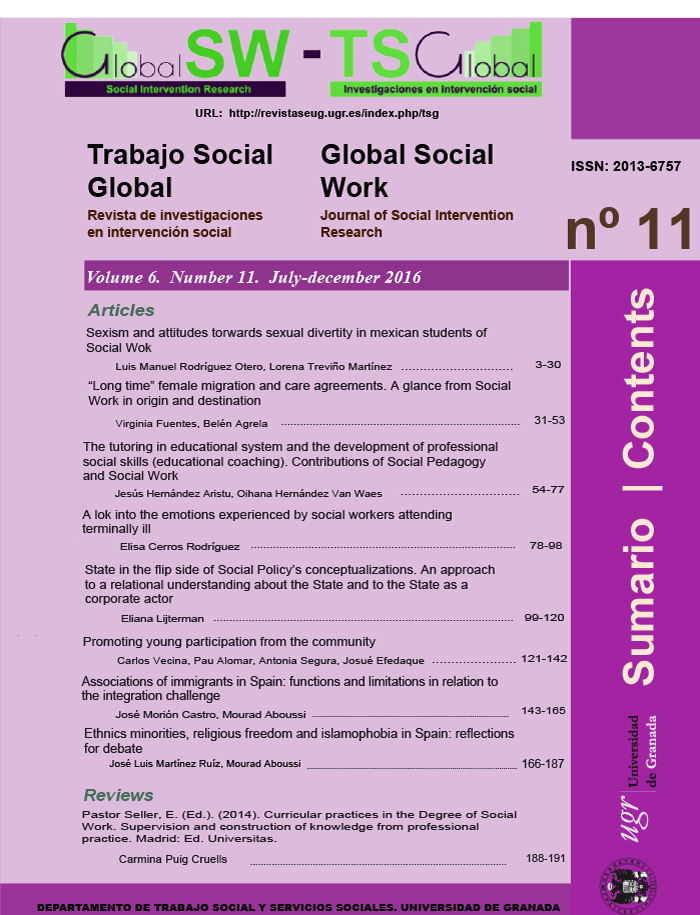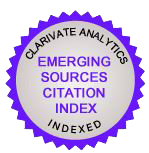Promoting young participation from the community
DOI:
https://doi.org/10.30827/tsg-gsw.v6i11.5214Keywords:
Community development, young, Participative Research, socioeducational interventionAbstract
This paper presents the beginning of a socioeducational experience with young people, which has the aim to enhance its role in the community, boosting the youth group to be this same who organize and manage their leisure and free time. The initiative is based on a previous study, the Community Monograph, prepared from a Participatory Research and Community programming and diagnostics, whose conclusions community challenges that must be addressed from its protagonists are raised; one of these lines involves young people as an alienated group of the context in which they live, an urban space that gradually has increasingly become a place for leisure and tourism consumption, being part of the resident population and their needs daily outside this process of gentrification. The initiative is part of the Intercultural Community Intervention Project (ICI) driven by the Obra Social "la Caixa", managed in Palma (Balearic Islands) by the GREC partnership and cooperation of the City Council. This is one of the 39 territories in Spain in which the project is implemented. Its general objectives are to promote conviviality, social cohesion, promoting local development and improve the living conditions of the population.
Downloads
References
Ballester, L. (2014). Una reflexión e investigación interdisciplinar sobre el espacio urbano. En Ballester, Pascual y Vecina (coords.) Comunidad, Trebajo en Red e Intervención Socioeducativa (pp. 43-67). Palma: Universitat de les Illes Balears.
Ballester, L., Muñoz, A. (2009). Treball comunitari: treball socioeducatiu en xarxa. IN. Revista Electrònica d’Investigació i Innovació Educativa i Socioeducativa, V. 1, n. 1, 91-108.
Ballester,L.; Orte,C.; Rosa,J.M. (2001). “Evaluación integral de programas. Rehabilitación integral de barrios. La experiencia de Palma de Mallorca.” Educació i Cultura. Universitat de les Illes Balears. Número monográfico sobre Evaluación Educativa. 14. Palma.
Bolívar, A. (2006). Familia y escuela: dos mundos llamados a trabajar en común. Revista de Educación, n. 339, 119-146.
European Comission (2016). Erasmus +. Guía del programa (Versión 2). Bruselas: Unión Europea.
European Comission (2016). Erasmus +. Guía del programa (Versión 2). Bruselas: Unión Europea.
Fernández, T. y López, A. (2008). Trabajo social comunitario: Afrontando juntos los desafíos del siglo XXI. Madrid: Alianza Editorial.
Francés, F.J. (2008). El laberinto de la participación juvenil: estrategias de implicación ciudadana en la juventud. Revista OBETS, 2, 35-51.
Freire, P. (2000). Pedagogía del oprimido. Madrid: Siglo XXI.
Giménez, C.; Álamo, J.M. y Pérez, F. (2015). Juntos por la convivencia. Claves del Proyecto de Intervención Comunitaria Intercultural. Barcelona: Obra Social “la Caixa”.
Glass, R. (1964). London: aspects of change. London: MacGibbon & Kee.
Hiernaux-Nicolás, D. y González-Gómez, C.I. (2014). Gentrificación, simbólica y poder en los centros históricos: Querétano, México. Scripta Nova, (12) 493, 1-15.
Longás, J.; Mireia Civís, M.; Riera, J.; Fontanet, A.; Longás, E.; Andrés, T. (2008). Escuela, educación y territorio. La organización en red local como estructura innovadora de atención a las necesidades socioeducativas de una comunidad. Revista Interuniversitaria de Pedagogía Social, 15, 137-151.
Marchioni, M. (2004). La acción social en y con la comunidad. Zaragoza: Certeza.
__________ (2010). Comunidad, Participación y Desarrollo. Madrid: Editorial Popular.
Marchioni, M. y Vecina, C. (2014). “Iniciativas comunitarias, convivencia e interculturalidad”. En Ballester, Pascual y Vecina (coords.) Comunidad, Trebajo en Red e Intervención Socioeducativa (pp. 287-340). Palma: Universitat de les Illes Balears.
Ministerio de Sanidad, Servicios Sociales e Igualdad (2014). Estrategia Juventud 2020 y Plan de Acción 2014-2016. Madrid: Gobierno de España.
Minguijón, J. y Pac, D. (2012). 15 M. Una explicación en clave sociológica. Prisma Social, 8, 414-439.
Pascual, B. (2007). La evaluación de la intervención comunitaria: un marco para la reflexión. Pedagogía Social, 14, 129-138.
________ (2014). “Ciudadanía, capital social y desarrollo comunitario”. En Ballester, Pascual y Vecina (coords.) Comunidad, Trebajo en Red e Intervención Socioeducativa (pp. 119-134).
Palma: Universitat de les Illes Balears.
PMH, (2015). Padrón Municipal de Habitantes, Palma: Ayuntamiento de Palma.
Salinas, L.A. (2013). Gentrificación en la ciudad latinoamericana. El caso de Buenos Aires y Ciudad de México. GeoGraphos, (4) 44, 283-307.
Secretaría de Estado de Educación y Formación Profesional (2011). Objetivos Educativos Europeos y Españoles. Estrategia Educación y Formación 2020. Madrid: Ministerio de Educación, Gobierno de España.
Vecina, C.; Segura, A. y Alomar, P. (2015). Monografía comunitaria Santa Catalina y es Jonquet, 2015. Palma: GREC, Ajuntament de Palma y Obra Social “la Caixa”.
VVAA (2013). Quadern de la plaça. Monografia Comunitària de Salt. Salt: Obra Social “la Caixa, Ajuntament de Salt i Casal del Infants.
VVAA (2015). Documentos del Proyecto. Proyecto de Intervención Comunitaria Intercultural. Barcelona: Obra Social “la Caixa”.
Downloads
Published
How to Cite
Issue
Section
License
Authors publishing in this journal agree to the following terms:
- Authors retain their copyright. They guarantee to this journal the right to a first publication of the work submitted to initiate the editorial process.
- Authors know that their work is published under a Creative Commons License which allows others to share it, with a recognition of the work's authorship and its initial publication in this journal.
- Authors share with Global Social Work explotation rights of the work that has been published in this journal, authorizing the execution of a free reproduction, distribution and public communication. Authors know that their work will be stored on servers and reproduced in digital format for inclusion in institutional repositories and databases that will facilitates free access to the full text of the work.
- Authors may distribute the version of the work published in this journal (for example, to an institutional repository or publish it in a book), with the explicit acknowledgment of its initial publication in this journal.
Copyright on the texts published in Trabajo Social Global -Global Social Work, as well as editorial policy of the journal refering to self-file and deposit in institutional or thematic repositories, are identified in the database





















